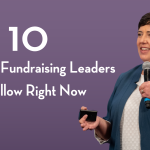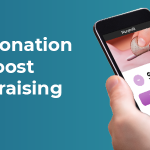11 Tips to Promote Your Hybrid Event to a Virtual Audience
You’ve made the decision to take your event hybrid, but you’re concerned you won’t have a virtual audience because of Zoom fatigue. How are you going to get your guests to attend your virtual event? We have some ideas!
There are many ways to get creative about this event model. The key is to make it authentic to your work and your audience. Hybrid events are proving to be successful in bringing people together to support a great cause—and they’re even out-performing in-person events in a lot of ways.
11 Tips to Promote Your Hybrid Event to a Virtual Audience
1. Use a Simple Livestream Site to Broadcast Your Event
Many people are tired of using Zoom-like platforms for work meetings every day. They don’t want to log into Zoom and watch your event. It’s often challenging for donors to remember their credentials, log in and download the most up-to-date version—the pain points are endless.
We recommend you work with an AV team to create a simple website that your donors can go to, watch the event, chat and donate. This site becomes a one-stop-shop for all donor needs, creating ease and getting your event out of the Zoom box frame.
2. Make It Free to Attend
One of the benefits of the hybrid event model is the ability to remove barriers to participation. You’re no longer limited by ballroom capacity and geographic boundaries. Hybrid events give you the opportunity to be inclusive of all possible attendees.
We recommend removing any ticket price for your virtual broadcast and focusing on powerful storytelling and setting the expectation of giving during the event.
Without ticket-price restrictions, you can now think about your audience in a very different way, including beyond your physical location. We’re seeing attendance for hybrid events from donors all across the country, even internationally.
Engage your community, clients, staff, volunteers, partners, donors, board members, families and friends and encourage them to invite their networks. There’s no limit to your virtual audience.
3. Promote the Rule of 7-10
Hybrid events—like all events—need a robust communications plan to build interest. Possible guests need to hear about the event at least 7-10 times before they take action. This will give your organization the best chance to develop the largest audience.
Create announcement communications including customized communications for your staff, board, committee members and sponsors and other stakeholders tailored to the different ways they can support you.
Then move to promotions meant to drive attendance through powerful storytelling and highlight key event components. Perhaps you have a mission-centric performance or the opportunity for guests to hear from a person who’s been directly impacted by your work. Let guests know what they have to look forward to and how this event is special.
We’re big believers that people need 7-10 touch points before they take action and plan to attend. So be inclusive of many touch points in your plan. A printed invitation is a great way to pull your message up out of the noise.
Finally, make sure you have a strategy for the weeks leading up to the event, reminding your guests how to tune in and when.
4. Activate Your Networks
Craft an email for your board, staff, volunteers and supporters to share. Encourage them to use their own social media channels and connections to invite people to tune in. Ultimately, the first rule of fundraising is that people give to people. And that certainly applies here! People will tune in and give when personally invited.
5. Incorporate a Host Model
Many events have a history of table hosts or captains who purchase tables and invite their friends. They should be activated to do the same thing in a hybrid event—even on the virtual side, without the physical table.
They could host their guests virtually over a Zoom call before or after the event. Or they could host a watch party with a small group of people at their home.
As a benefit, you could also consider purchasing or facilitating catering for them and their guests. Many catering companies can deliver and are open to adding new features to their catering beyond just food, like flowers and party favors.
6. Set up a Phone Bank
Competing for the attention of your possible guests in this environment can be challenging. Making the personal connection before your event is now more important than ever. Set up a phone bank for the week before the event to make sure that the guests you most want to be engaged are planning to attend. And remember to be thoughtful of who the messenger is; the person with the relationship should be making the call. The personal, direct invite ask is very powerful.
7. Stream on Social Media
Livestreamed events on platforms such as Vimeo or YouTube are great for simulcasting across social media platforms, such as Facebook Live. Work with your AV partners to see if it’s possible to simulcast your livestream to bring in additional audience members. It will require a Facebook administrator to facilitate the stream during the event and you’ll want to identify a volunteer to moderate the chat function.
8. Crowdsource Content
People are more likely to show up for the event if there’s a chance they might see themselves or loved ones featured during the program. Consider incorporating some kind of slideshow or compilation of videos that feature familiar faces—those of staff, members, donors, etc.
They could record a power statement, a simple toast or send in a meaningful photo. This can also be used to lift your storytelling, show the power of your community and connect your virtual audience with your in-person one.
You could also consider creating a hashtag campaign to gather people’s contributions.
9. Incentivize Participation
Find something simple that you can offer to potential guests to get them to RSVP before the event. This could be something small that every person receives, or it could be one larger package of general interest that registrants get entered into a drawing to win. You can also provide live drawings during the program for people viewing the event. This way your audience has an incentive to engage and stay logged in. Don’t spend too much time procuring this type of package. It should be something at your fingertips.
10. Send a Calendar Invite
We’re living in a virtual world, which means we all rely on our digital calendars to find links for easy login. The same should be considered for your event. Add an “Add to Calendar” link to your email communications and RSVP confirmations so attendees can easily add the details of the event to a calendar with all of the information needed to tune in.
11. Say Thank You with a Small Gift
Many organizations are finding success in getting people to attend by delivering a little gift to the viewer’s home the week of the event. This doesn’t need to be catering or anything huge to get people to tune in—just a small gift that says, “We appreciate you, and we can’t do this without you. We hope you join us.”
A bottle of wine and some chocolates with a handwritten note reminding them to attend is a perfect example.
Planning your next fundraising event? We’d love to hear about it. Reach out to us here.






